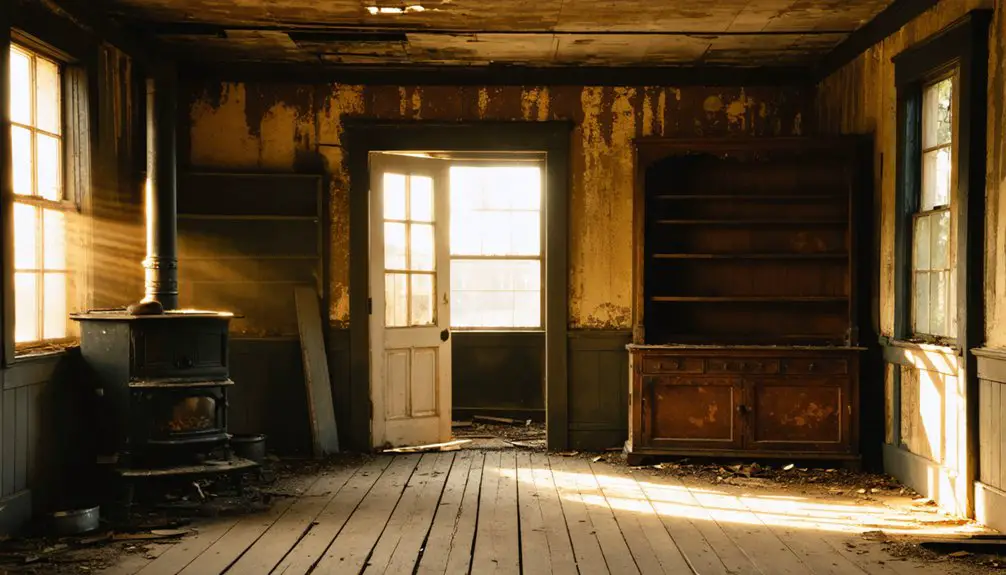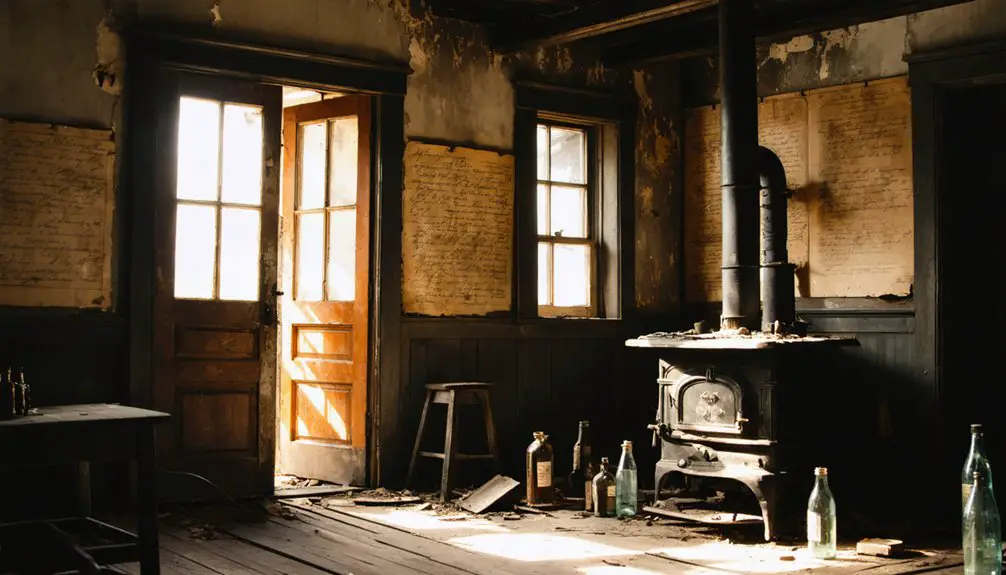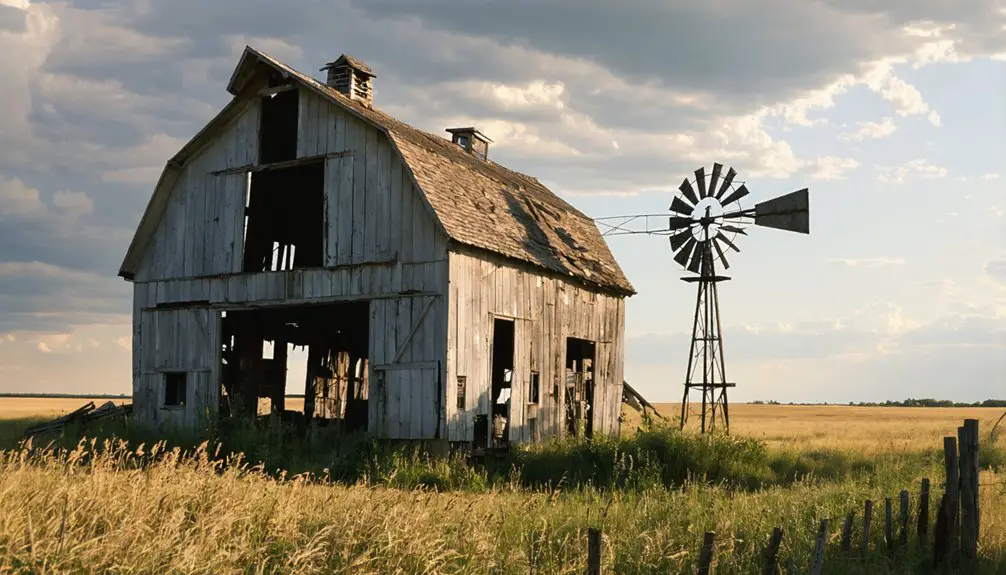You’ll find the ghost town of Pelan in Roseau County, Minnesota, where it once served as the county seat from 1894-1909. Founded in 1883 by Charles Pelan, this frontier settlement peaked with 175 residents by 1902. While stagecoaches like the Kitty and Medora connected early settlers, the town’s fate was sealed when major railroads bypassed it. Today, only a few structures remain, including Hans T. Olson’s log house, each holding untold stories of frontier life.
Key Takeaways
- Pelan was established in 1880 and reached its peak population of 175 residents by 1902 before becoming a ghost town.
- The town’s decline began in 1909 when it lost its county seat status to Roseau and was bypassed by major railroad developments.
- Economic collapse accelerated after the creamery closed in 1905 and businesses relocated to railroad-connected towns.
- Only a few original structures remain, including Hans T. Olson’s log house and the town’s original schoolhouse.
- Modern archaeological investigations use Ground Penetrating Radar to study structural foundations and uncover artifacts from Pelan’s frontier past.
The Founding of Pelan (1883)
Three years before its official establishment, settlers began arriving in what would become Pelan, Minnesota in 1880.
You’ll find this frontier town’s founding significance tied to Charles Pelan, a wealthy Englishman who settled in Kittson County and lent his name to the community. Early demographics show a modest but steady influx of pioneering families throughout the 1880s, each contributing to the town’s development.
The settlement’s strategic location made it an important stagecoach stop, connecting the growing community to neighboring towns across northwest Minnesota. Two stagecoaches named the Kitty and Medora were purchased in 1896 to serve the growing transportation needs.
As families arrived, they worked together to build essential structures, including a schoolhouse where each household contributed logs. This collaborative spirit marked Pelan’s early character as a close-knit frontier settlement determined to forge its place in Minnesota’s expanding territory.
The town grew around the log house of Hans T. Olson, which became a central gathering point for the developing community.
Early Settler Life on the Minnesota Frontier
If you’d settled in Pelan during the 1880s, you’d have faced the harsh realities of Minnesota’s frontier life, including brutal winters and the immediate need to clear dense forest for farming.
You would’ve needed to construct your home quickly using local timber, typically building a one-room log cabin with a dirt floor and simple roof of cedar shakes or sod. Like many settlers before the territorial era, you might have found yourself relying heavily on the fur trade economy to make a living.
The Grange movement, started by Oliver Hudson Kelley, helped frontier farmers advocate for their interests and improve their farming practices through community organization.
Your daily survival would’ve depended on mastering essential skills like hunting, food preservation, and maintaining your shelter against the elements while dealing with limited access to supplies from the nearest trading posts.
Daily Pioneer Challenges
Life on the Minnesota frontier presented settlers with a relentless array of daily challenges that tested their resilience and resourcefulness.
You’d spend at least eleven hours daily tackling essential tasks, from breaking thick prairie sod to maintaining crude shelters made of mud and sod.
Pioneer resilience was tested by Minnesota’s harsh weather – droughts, hail, blizzards, and tornadoes wreaked havoc on your farming efforts.
Your survival strategies had to account for devastating locust swarms that could destroy entire harvests, while securing enough food and fuel to endure long winters.
Without reliable access to doctors or midwives, you’d face health challenges alone.
The isolation was profound, with limited transportation infrastructure making communication between settlements difficult.
The Euro-American population exploded from 4,535 in 1849 to over 172,000 by 1860 as more settlers arrived.
You’d often supplement your uncertain farming income by working in lumber camps or trading locally.
High railroad shipping rates made transporting crops and supplies a significant financial burden for settlers.
Frontier Housing Construction
Among the many challenges pioneers faced, securing adequate shelter ranked as their immediate priority upon reaching the Minnesota frontier.
You’d find settlers using whatever local materials they could get their hands on – timber, limestone, or thick prairie sod. If you’d settled in a wooded area, you might’ve built using balloon framing, a revolutionary technique that made construction faster and lighter than traditional log cabins. These sod homes were quicker to build than traditional wooden structures and cost less due to the readily available materials.
On treeless prairies, you’d stack blocks of sod to create walls, often protecting them with stucco or canvas to prevent rain damage. By the 1840s, balloon frame construction had become the standard building method across Minnesota.
Most frontier homes started small and simple, with plans to expand as your farm prospered.
You’d typically begin with basic rooms – a main living area and bedrooms – while positioning windows and doors strategically for light, ventilation, and security.
Peak Years as Roseau County Seat
During the late 19th century, Pelan served as the county seat of Roseau County, marking the pinnacle of its brief but significant administrative role in northern Minnesota.
You’ll find that Pelan governance centered around essential functions like hosting government meetings and providing postal services through its post office, established in 1888.
Originally incorporated as Twin Lake City in 1901 and later renamed after Charles Pelan, this frontier town managed county shifts during northwestern Minnesota’s settlement expansion. The town’s multiple names required careful disambiguation efforts to maintain accurate historical records.
While its population remained modest, Pelan’s position as an administrative hub justified its temporary status.
The establishment of Roseau County on December 31, 1894 set the stage for Pelan’s role as an early county seat.
However, by 1909, you’d have witnessed the town’s decline as the county seat shifted to Roseau, reflecting the region’s changing demographics and the need for a more accessible administrative center.
Transportation and Trade Routes
Transportation infrastructure proved decisive in Pelan’s fate, as the town found itself bypassed by major railroad developments in the early 1900s. While the Soo Line railroad served Karlstad to the southwest and the Great Northern connected through Greenbush to the east, Pelan remained stranded inland without rail access.
The evolution of regional transportation networks sparked a dramatic shift in trade patterns. You’ll find that businesses, including the creamery, mills, and saloons, abandoned Pelan for railroad-connected towns.
By 1905, the creamery’s closure signaled the collapse of local commerce. The physical relocation of buildings and services to Karlstad and Badger reflected this transformation.
Though Minnesota’s improving road systems later enabled automobile and bus travel, Pelan’s decline was already sealed by its isolation from the rail lines that dominated early 20th-century trade routes.
Notable Buildings and Landmarks

You’ll find few remnants of Pelan’s bustling commercial district today, though historical records show it once featured two general stores among its 24 businesses during the town’s peak around 1903.
While the town pursued a railroad connection that would have brought a depot, its failure to secure rail access in 1907 contributed considerably to Pelan’s decline.
The absence of both the general stores and a railroad depot today reflects the dramatic transformation of this once-thriving settlement into a ghost town, with only a handful of original structures surviving, including Hans T. Olson’s relocated log house and the original schoolhouse.
Historic Pelan General Store
A prominent fixture of early Pelan, the general store first opened its doors in 1899, occupying a 30-by-60-foot building that quickly became the town’s commercial heart.
Store operations expanded considerably when O.M. Edsill purchased it in 1908, adding living quarters and a hardware section to meet growing community needs.
As one of 24 businesses during Pelan’s incorporation in 1903, the store served as a hub for community gatherings and commerce.
- You’ll find it was more than just a shop – it was Pelan’s social nucleus where locals shared news and connected
- The addition of telephone service in 1902 transformed it into an essential communication center
- The store supported a thriving population of 175 residents by 1902
Despite the town’s decline after failing to secure railroad access, the store persisted under various owners until 1953.
Railroad Depot Ruins
While the general store served as Pelan’s social hub, the railroad depot stood as a symbol to the town’s once-promising future.
You’ll find the depot ruins near what was once Pelan’s main street, now largely overtaken by new construction and a junkyard. Though little remains of the depot architecture today, this modest station played a crucial role in connecting the town’s 200 residents to Minnesota’s expanding rail transportation network.
The depot facilitated the movement of both passengers and freight, linking Pelan to the Great Northern Railroad’s larger system. Unlike grander terminals like Saint Paul Union Depot, Pelan’s station was utilitarian in design, reflecting its small-town status.
Today, you can explore the site’s history at nearby Pelan Park, where local historical societies preserve the memory of this once-bustling transportation hub.
The Town’s Gradual Decline
Despite Pelan’s promising start as a frontier settlement, the town’s fate was sealed when both the Soo Line and Great Northern railroads bypassed it in the early 1900s. The economic impacts were swift and devastating, leading to a mass community migration that would ultimately dissolve the village.
You can trace Pelan’s decline through these key events:
- The creamery’s brief existence from 1904-1905 marked the beginning of business failures.
- Local saloons and the flour mill relocated to railroad-connected towns.
- Population dropped from its 1902 peak of 175 residents.
- By 1909, the village officially unincorporated.
Within just a few years, you’d have witnessed the exodus of essential services, including the town’s doctor, attorney, and newspaper.
The once-bustling frontier town transformed into another Minnesota ghost town, demonstrating how vital railroad access was to survival.
Archaeological Discoveries and Preservation

Modern archaeological investigations of Pelan’s remains tell a complex story of frontier life and abandonment.
You’ll find compelling evidence through archaeological methods like Ground Penetrating Radar, which has revealed hidden structural foundations beneath the surface. Hans T. Olson’s log house and the original schoolhouse stand as rare survivors of the town’s heyday, while preservation efforts focus on documenting these remaining structures before they’re lost to time.
The site’s archaeological value extends beyond visible remains.
Excavations near existing structures have uncovered artifacts that match patterns found in other Minnesota ghost towns, including trade goods and everyday items. While much of the main street lies beneath modern construction, careful investigation of the surrounding area continues to yield insights into the community’s daily life and ultimate decline.
Visiting the Site Today
Before visiting Pelan’s abandoned townsite in northwestern Minnesota, you’ll need to carefully plan your approach using the coordinates 48.66889°N, 96.41389°W as your starting point.
Modern exploration of this ghost town requires thorough preparation since it’s situated in remote Kittson County with limited services and cell coverage.
Venturing into Pelan’s remote landscape demands careful planning, as this isolated ghost town lies beyond reliable modern conveniences.
Essential preparations for your visit:
- Stage from Karlstad or Greenbush for final supplies and fuel
- Verify land ownership and obtain necessary permissions from Kittson County offices
- Pack emergency supplies and satellite communication devices
- Plan around weather conditions and agricultural activities
The site consists mainly of foundation remains and reclaimed farmland.
You’ll need sturdy boots to navigate uneven terrain and possible hazards.
Contact local authorities regarding road conditions, especially during spring thaws or winter weather.
Frequently Asked Questions
Were Any Famous Outlaws or Criminals Ever Known to Visit Pelan?
You won’t find any documented outlaw sightings or criminal legends in Pelan’s history. The town’s isolation, small population, and lack of railroad access kept notorious outlaws away.
What Happened to the Original Residents After Leaving Pelan?
You’ll find most residents’ relocation led them to Karlstad and Greenbush, while others scattered across Kittson County. Their community legacy lived on through the church and buildings they moved to Pelan Park.
Are There Any Documented Paranormal Activities at the Ghost Town Site?
You won’t find any officially documented ghost sightings or supernatural encounters at this site. While Minnesota ghost towns often attract paranormal rumors, there’s no verified evidence of haunting activity here.
Did Any Major Epidemics or Natural Disasters Contribute to Pelan’s Abandonment?
You won’t find epidemic impact or disaster aftermath in Pelan’s decline. Historical records show it’s purely economic – the town died after being bypassed by major railroad lines in the early 1900s.
What Native American Tribes Originally Inhabited the Pelan Area?
You’ll find that both Dakota and Ojibwe peoples inhabited this northwestern Minnesota region, with Dakota culture dominating earlier, followed by Ojibwe heritage becoming prominent during their westward expansion in the 1700s-1800s.
References
- https://roseaucohistoricalsociety.org/5644-2/
- http://freepages.history.rootsweb.com/~gtusa/usa/mn/pelan.htm
- https://en.wikipedia.org/wiki/Pelan
- http://freepages.rootsweb.com/~gtusa/history/usa/mn.htm
- https://www.sdhsf.org/news_events/history_articles.html/title/january-2021-the-travels-of-kittie-the-stagecoach
- https://en.wikipedia.org/wiki/Territorial_era_of_Minnesota
- https://mlpp.pressbooks.pub/mnhist/chapter/wheat-pine-and-iron-the-late-nineteenth-century/
- https://en.wikipedia.org/wiki/History_of_Minnesota
- http://www.gutenberg.org/ebooks/25677
- https://www.patheos.com/blogs/anxiousbench/2020/02/home-missionaries-history/



